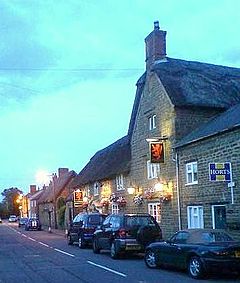Crick, Northamptonshire
| Crick | |
|---|---|
 Main Road, Crick (now bypassed) and the Red Lion Inn |
|
| Crick shown within Northamptonshire | |
| Population | 1,886 (2011 Census) |
| OS grid reference | SP587726 |
| • London | 78 miles (126 km) |
| Civil parish |
|
| District | |
| Shire county | |
| Region | |
| Country | England |
| Sovereign state | United Kingdom |
| Post town | DAVENTRY |
| Postcode district | NN6 |
| Dialling code | 01788 |
| Police | Northamptonshire |
| Fire | Northamptonshire |
| Ambulance | East Midlands |
| EU Parliament | East Midlands |
| UK Parliament | |
Crick is a village in the Daventry district of the county of Northamptonshire in England. It is close to the border with Warwickshire, 6 miles (9.7 km) east of Rugby and 14 miles (23 km) north-west of Northampton. The villages of Crick and West Haddon were by-passed by the A428 main road from Rugby to Northampton when the Daventry International Rail Freight Terminal (DIRFT) was built in 1996. The terminal is a short distance east of junction 18 of the M1 motorway, which is next to Crick. Crick's population in the 2001 census was 1,460, increasing to 1,886 at the 2011 census.
Crick takes its name from the Celtic word for 'hill' (Cruc). Crack's Hill (grid reference SP595736) is about a mile north-east of the village, next to the canal, and gives good views of Crick, Yelvertoft, West Haddon and Rugby from the top.
The Historic England website contains details of a total of 48 listed buildings in the parish of Crick, all of which are Grade II except for St Margaret’s Church which is Grade I. Details of some of these are as follows:
This building was erected in a perpendicular style in the 14th and 15th centuries, incorporating some 12th-century work. It includes a nave, two aisles, north sacristy, south porch and west tower. The walls are constructed of coursed ironstone and limestone rubble, with coursed ironstone and sandstone in the tower. The roofs are of tile and lead. There is a Romanesque sandstone font, whose base consists of three crouching figures. It was restored in 1840 by RC Hussey, and thus contains a number of elements from that era.
...
Wikipedia

